The Science Behind Cat Coat Colors & Patterns: A Fascinating Look into Feline Genetics
Unveil Fascinating Cat Coat & Pattern Secrets
Have you ever stopped to admire a cat’s coat? The patterns and colors are amazing. Each cat’s coat is a unique masterpiece.
The genetics behind cat coats are fascinating. We can learn about them with science and wonder. Let’s explore the fascinating world of cat coats and learn some surprising facts.
Did you know that the fictional cat Garfield whom we all adored during our mellow childhood days was actually a red tabby Exotic Short hair? But as baffling as “red tabby Exotic Short hair” might sound, it is a cat’s distinct coat colour, pattern and fur length that makes each and every little feline so magnificently stunning and charming. These little furballs have the most eclectic and diversified range of coat colours and patterns that not only sets them apart from each other, but also speaks volumes about their demeanor in general.
A long-haired cat doesn’t walk—she glides, wrapped in silk and mystery.
The Colorful World of Feline Genetics
Cats’ colorful coats are not just pretty. They are also a result of complex genetics. The main cat coat colors come from genetics, which control melanin production and distribution.
There are two melanins in cats: eumelanin for black and dark brown, and pheomelanin for red and yellow. The mix of these melanins and genetics leads to many coat colors and patterns in cats.
The basic colors of cat coats are black, blue, chocolate, lilac, red, and cream. These colors can be solid or mixed with other genes to create patterns like tabby, tortoiseshell, and pointed.
Genetics play a big role in cat coat colors. For example, the gene for black pigment can be changed by other genes. This results in different shades and tones. Knowing how these genes work helps us understand cat coat diversity.
Also, melanin affects a cat’s eyes and nose color. The genetics of coat color can also impact a cat’s health and disease risk.
It is really exciting for all the feline admirers, ailurophiles and potential cat parents to learn and acquaint themselves with the various different types of colours and coats that a cat comes in. Genetic mutations or selective breeding are primarily the major reasons of each kitty having the most resplendent and beautiful coat patterns, but however in case you are bewildered between the adorable calicos or the cute as a button torties, the opulent bi-colours or the wonderful tabbies and amongst several other kitty’s coat colour prints, well then fret not as we are here to your rescue. We’ll help you recognize and classify these gorgeous felines, and by the end of this blog, you would undoubtedly be flaunting your newly acquired “cat” expertise by distinguishing amongst the differently patterned cattos.
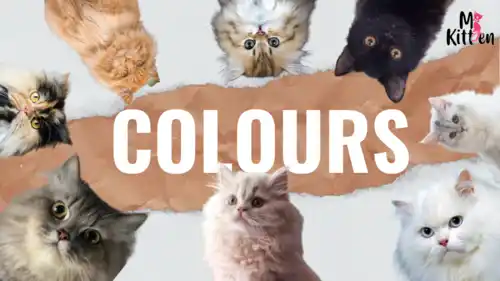
Fascinating Facts Regarding Different Cat Coats & Patterns
Cats have coats that range from sleek self-colors to detailed tabby patterns. This variety is truly amazing.
The self-color or solid coat pattern is simple yet eye-catching. It has a uniform color without any patterns. Cats like the British Shorthair and Russian Blue often have this coat. They come in colors like blue and chocolate.
The genetics of a self-color coat are interesting. It happens when pigment is evenly spread across the hair. This makes cats look solid in colors like black, white, and red.
Getting a perfect self-color coat is hard. It needs the right genes to hide other patterns. This shows how simple and pure some cat coats can be.
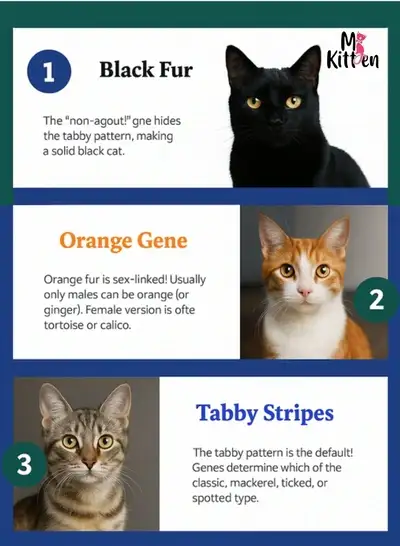
Self-Color/Solid Coat Patterns: One Color to Rule Them All
Cat coat patterns are interesting, and the self-color or solid pattern is unique. A self-color cat has a coat that is all one color. No other colors or patterns show.
The genetics of a self-color coat involve two melanins: eumelanin (black and dark brown) and pheomelanin (red and yellow). How these melanins mix decides the coat color. For a solid coat, a cat needs a special genotype. This genotype stops other colors or patterns from showing, making the coat look uniform.
Bi-color cats have two colors, unlike self-color cats with just one. But, bi-color cats are also beautiful in their own way. Their genetics let them show two colors, making a striking contrast.
Self-color cats are special because of their simple, consistent coat color. Whether it’s a black cat or an orange one, their pattern shows the amazing world of cat genetics.
A cat that has a single coloured coat evenly distributed all over her body is the one with a solid coat pattern. There are primarily four basic solid or self – colours in cats namely black, red (orange), cinnamon and chocolate. White however is considered as an absence of colour rather than a colour, per se. Also when a kitten is really young, it might have a few tiny patches of a secondary colour, but as the kitty matures, the odd fur colour fades away and the cat’s coat pattern becomes solid coloured all over. Furthermore, it is interesting to note that the same colours are referred to by different names in different breeds, and even if the same breed, the colour might have different names depending on which country the cat is from. If a cat possesses any other coloured splotch on her coat, she is not regarded as a solid coat type.
- The jet-black coloured kitty is referred to as “Ebony “.
- The Abyssinian cat also has a solid coat pattern with a deep and a warm reddish-brown base.
- Red cats are the Red Tabby cats because of a non – agouti gene ( the gene that is responsible for turning a tabby into a solid/self colour) which does not manipulate with the way the red pigment is deposited. Also a variety of other genes that are known as the modifiers or the polygenes control the intensity of the cat’s coat colour. Selectively breeding cats with least red markings has
successfully produced solid red cats who have a self – colour coat pattern.
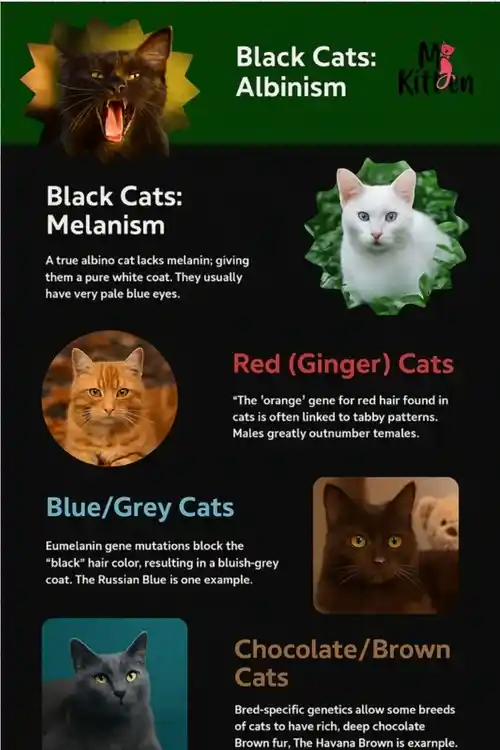
Colour Point Coat Pattern
The colourpoint coat pattern is usually associated with Siamese cats, but it may be found in any domesticated cat. A colour pointed cat has a darker coat color on the face, ears, tail and feet, and has a lighter shade of the same coat colour on the rest of its body, along with some white. The exact name of the colourpoint pattern is based on the actual color, and hence there are the following categories under the colour point cat coat pattern –
- Seal Point (dark brown)
- Blue Points (dark gray)
- Chocolate Points (warm lighter brown)
- Frost or Lilac Points (silvery gray-pink)
- Tortie Points (tortoiseshell mottling)
- Flame or Red Points (Orange)
The colour point coat pattern is primarily caused by virtue of a temperature sensitive mutation in one of the enzymes of metabolic pathway, such as the melanin, and hence almost little to no pigment is produced except in case of extremities or at points wherein the skin is slightly cooler. The colour pointed cats therefore darken with age as their body temperature drops, and the coolest part of the cat’s body becomes darker in colour.
Colour point pattern is actually temperature centric, and herein the body parts of a cat’s body, that are essentially cooler, tend to develop a darker coat colour as the cat grows up.
The colour points, as elucidated above, can also be present in tricolour pattern or in a tabby pattern, and the tabby colourpoints are referred to as “lynx”.
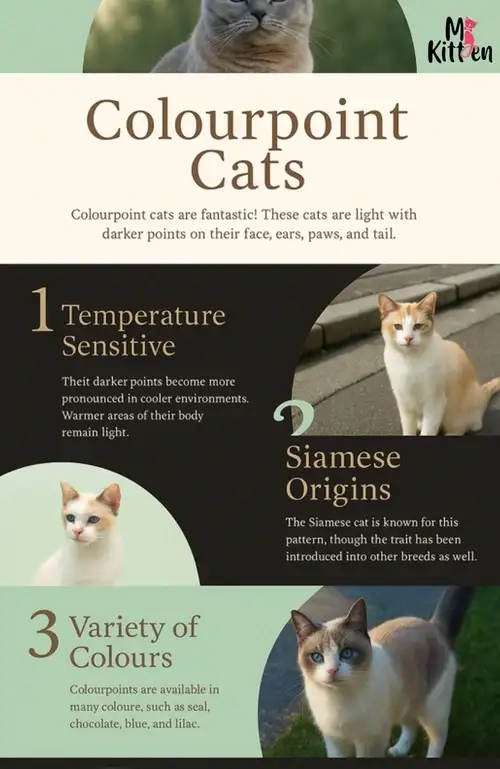
Bi-Color Coat Patterns: The Feline Fashion Statement
Bi-color cats are very common and very striking. They have two colors, often white and another color. This can vary a lot among different breeds.
The bi-color pattern comes from genes that control melanin, the pigment in hair. These genes can make cats mostly white with patches or mostly colored with white accents.
Bi-color cats are definitely eye-catching. Another interesting pattern is the tabby coat. It’s very common in domestic cats.
The tabby pattern has M-shaped markings on the forehead. It also has stripes or dots on the body. The legs, torso, and tail have dotted or striped patterns.
The tabby pattern is a mix of colors. It can be light brown or grey to vibrant orange or dark brown. It often has a distinctive ‘M’ marking on the forehead.
Bi – Coloured cats are those who possess a coat that is primarily white with one other colour. The other colour might be solid such as black or could even demonstrate a tabby pattern. The Bi-Colour pattern is extremely common amongst the mixed breed cats but it is widely prevalent in several feline breeds. This coat type is originally caused by the presence of the white spotting gene.
Bicolour coat patterns can occur in different breeds such as Cornish Rex,
British Shorthair, Exotic Shorthair, Cymric, Maine Coons, Norwegian Forest Cat, Manx, Persians and the Turkish Van and also in most domestic cats.
Harlequin is used for cat that has an almost all white coat.
A black cat that has a white belly, paws and also a white face is usually alluded to as a “Tuxedo” cat.
A black cat that has a single, small white patch on the chest, is referred to as a “locket” on the chest.
Van is a term for a specific variation wherein the cat’s coat is almost white, but has coloured patches only on the head, in- between the ears and has a coloured tail.
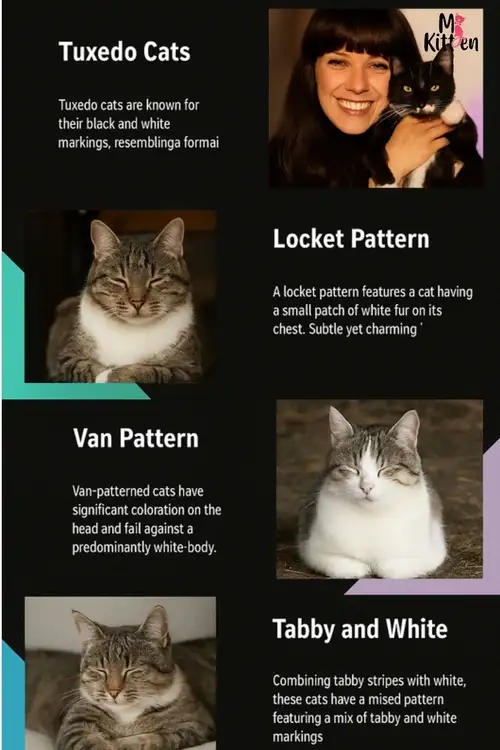
Tabby Coat Patterns: The Tiger in Your Living Room
The tabby coat pattern shows the genetic diversity of domestic cats.
This iconic pattern has M-shaped markings on the forehead. It also has stripes or dots on the body. Its unique genetic makeup makes it stand out.
The tabby pattern is not just one color. It’s a mix of colors that can vary a lot. This results in different tabby patterns, like the classic or blotched tabby, mackerel tabby, and ticked tabby.
The genetics behind the tabby coat pattern involve many genes. These genes control the production and distribution of melanin, the pigment that gives hair its color.
This complex interaction leads to the wide range of tabby patterns in domestic cats. It makes each tabby cat special and unique.
The most common and widely prevalent coat type in cats is the Tabby coat pattern. This coat has four variations that are succinctly explained below.
Striped (Mackerel) Tabby –
– A striped or a mackerel tabby has vertical stripes that run from his spine to his belly. Their stripes appear like narrow fish bones which may break up into spots or bars.
Spotted Tabby
– As the name suggests, a spotted tabby has stripes that break into spots that may be arranged horizontally or vertically. These spots are primarily caused by modification of the mackerel stripes.
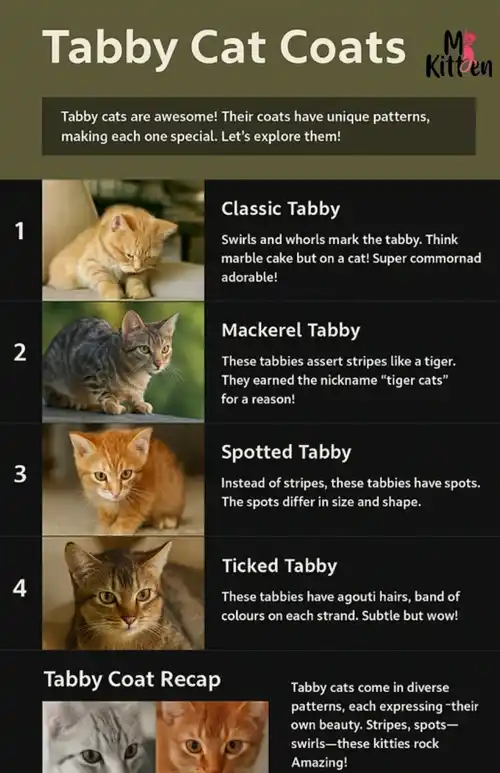
Calico / tri-color Coat
Pattern The adorable Calicos are known as mi-ke that means “triple fur in Japanese and lapjeskat that in Dutch, refers to a “patched cat”. Also as the name elucidates, the tricolor coat pattern is a mix of white, black and red (that is
orange/ ginger), or the subtle versions of blue and cream. A calico has large amounts of white with well defined patches of cream/red and blue/black coloured fur. However with intermediate amounts of white, a feline may even exude a tortie pattern, a calico pattern or something in between, that primarily depends on various epigenetic factors.
It is interesting to note that Calimanco or Clouded tigers are diluted calico cats with lighter coat colouration.
Just like Tortoiseshell tabbies are known as torbies, calico tabbies are refered to as Tabicos or Calibys.
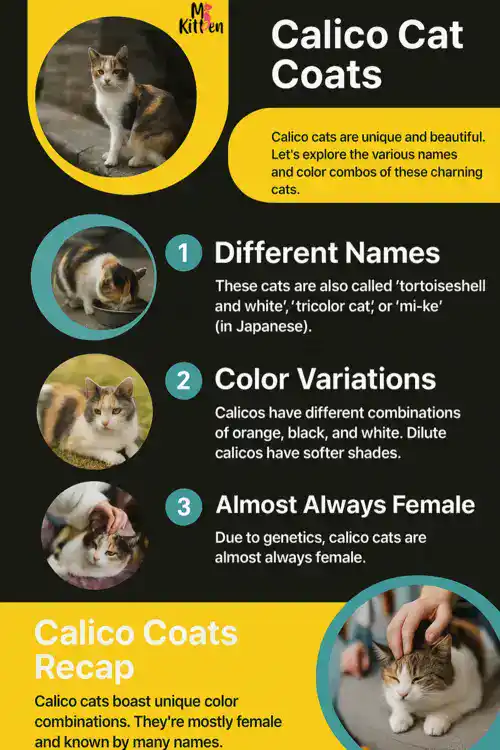
Blotched (Marbled) or Classic Tabby: The Swirled Masterpiece
The classic tabby coat pattern is special. It has a swirling effect that makes the cat’s fur look beautiful and detailed.
This pattern is known for an M-shaped mark on the forehead. The body shows a mix of darker and lighter colors in swirling patterns. It makes the cat look like it has a marbled fur.
A classic tabby has a swirly pattern on its coat that creates a beautiful marbled effect. The classic tabby pattern comprises of whorls, wide bands and dark-colored spirals on pale background that generally has an oyster pattern on flank or has bulls-eye. These marbled tabby cats are extremely common in Great Britain, Iran and in lands that were erstwhile under the British and the
Persian Empire.
Ticked ( Agouti) Tabby –
– The ticked tabby cats usually have striped legs and tail, albeit the rest of the body appears mottled by virtue of their agouti hair. Agouti hair is when each individual hair strand possesses more than one colour, that is generally black with an orangish / reddish brown.
Tabby cats generally demonstrate the following traits –
M on their foreheads with narrow pencil lines on face. ( This is particularly visible in ticked tabby cats, albeit hard to recognize on shaded golden or silver, and also tipped cats)
A Black “eyeliner” look with white or pale coloured fur that surrounds the eyeliner.
The lips and paws are pigmented
The nose of a Tabby is pink, albeit it is outlined in a darker pigment.
Torso, leg, and tail banding. (Torso banding ceases to be visible in the ticked tabby.

Bengal: The Wild-Looking Domestic, Indian Domestic Cats with Classic Patterns
Bengal cats often have this striking pattern. They are known for being energetic and playful. Their classic tabby pattern makes them stand out even more.
Indian domestic cats also show the classic tabby pattern. This shows the genetic variety in the region’s cats. Their different coat patterns and colors highlight the rich heritage of cats in India.
The classic tabby pattern is not just pretty. It helps the cat blend in and hunt. Even though domestic cats don’t hunt for food, their coat patterns are fascinating to cat lovers.
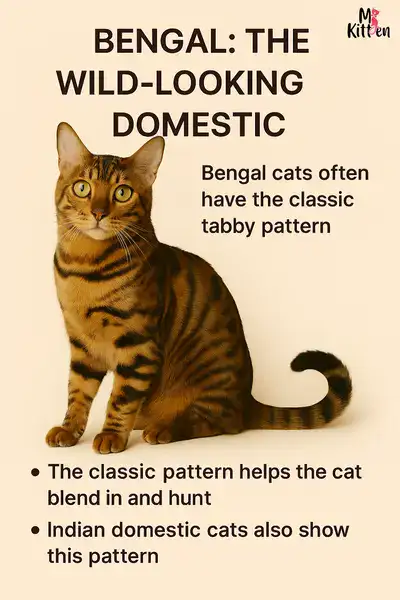
Tortoiseshell Coat Pattern
The cats with the opulent tortoiseshell coat pattern are a mix of orange and black or their subtle version is that of cream and blue coat. It is interesting to note that all tortoiseshell and calico cats are almost always female with approximately one in three thousand cats being a male tortie or calico, who took are always sterile right from birth. The reason for tortoiseshell and calicos always being female is because the orange coloured gene is carried on sex-linked X chromosome. Males however are XY that is they only have one X chromosome, and they can hence only be black or red, or of some other variation of each due to the modifying factors.
Females on the contrary are XX, and can ergo be both black and red, and that’s how we get the splendid tortie females who fundamentally have black coats with red splashes on it. If the female cat inherits the dilute factor, she would have a blue-cream coat colour, that is quite common in tortoiseshell cats. Torties can also have brindled coats wherein the two colours are mixed in equal proportion, or they might even have distinct patches.
Torbie is a female kitty who is a mix of a Tabby and a Tortoiseshell. Torbie cats have unique and distinct markings of both the coat patterns.
Male tortoiseshell are extremely rare but can occur by way of certain chromosomal abnormalities such as Klinefelter syndrome, by a phenomenon namely chimerism wherein two early stage embryos are fused into a single kitten or also by mosaicism.
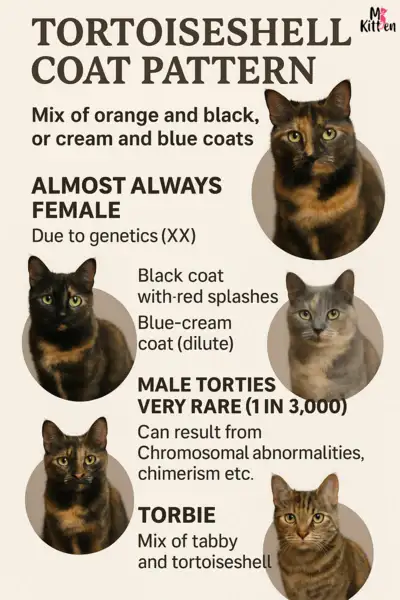
Rare and Extraordinary Cat Coat Patterns
Cat lovers are often amazed by the rare coat patterns some cats have. These patterns show nature’s incredible variety. They are not only beautiful but also tell us about a cat’s genes.
One rare pattern comes from a genetic condition that affects melanin. This leads to cool visual effects. For example, albinism means no melanin, so cats have white fur and blue or pink eyes.
Cats with “ticking” or “agouti” hairs have hairs with bands of color. This makes them look mesmerizing, like the Abyssinian breed.
The genetics behind these patterns are fascinating. They show how genes work together to create a cat’s look. Learning about these genetics helps us understand cats better.
Breeders and cat lovers find these patterns intriguing. They work hard to breed and keep these cats healthy. This community ensures these special cats are well cared for.
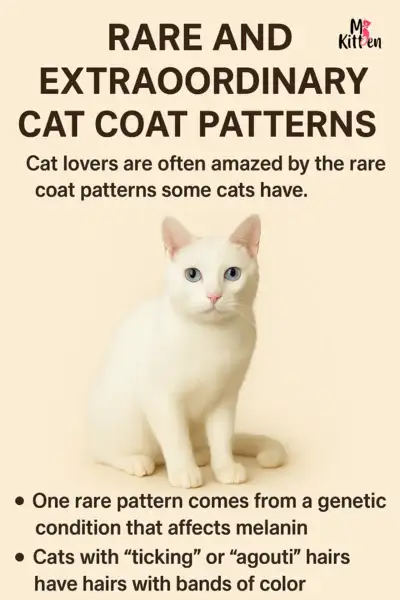
Caring for Your Cat's Magnificent Coat
Keeping your cat’s coat healthy and shiny is key. Whether they have a beautiful self-colour or a striking bi-colour coat, grooming is a must.
Cats with solid coats need skin care as much as their fur. Brushing regularly spreads skin oils. This helps prevent skin problems and keeps their coat shiny.
Cats with bi-colour coats also need regular grooming. It keeps their coat clean and healthy. Plus, it’s a great time to bond with your cat.
What your cat eats is also important for their coat. A diet full of omega-3 fatty acids, vitamins, and minerals is best. Make sure they always have fresh water too.
Don’t forget to take your cat to the vet regularly. A vet can give advice just for your cat. This helps keep their coat looking its best.
Along with that, always make a plan to keep your cat or kitten hydrated. Give your cat access to fresh and clear water. To make it easier, you can also add more wet food to their diet. Cats love wet food and it keeps them hydrated too. Furthermore, keep a tab on their grooming. After all, cats are beautiful creatures. Grooming makes it easy to flaunt their feline look. Also, grooming keeps your kittens and cats coats healthy and shiny.
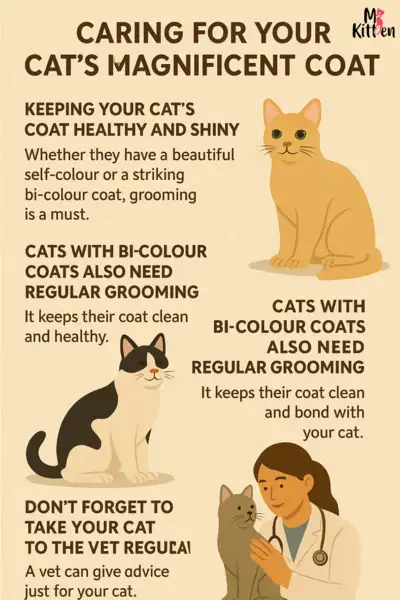
The Pawsome Legacy of Cat Coat Diversity
The main cat coat colours show the amazing variety of feline coats. Cats have sleek self-color coats, vibrant bi-colors, and cool tabby patterns. Each cat’s coat is a unique work of art.
The genetics behind this variety are complex. But the outcome is a stunning range of colours and patterns. These make each cat truly special.
If you love cats, the variety of their coats will amaze you. Whether you’re a cat breeder or just a fan, their coats are captivating. Next time you look at your cat, remember the beauty of their coat.
